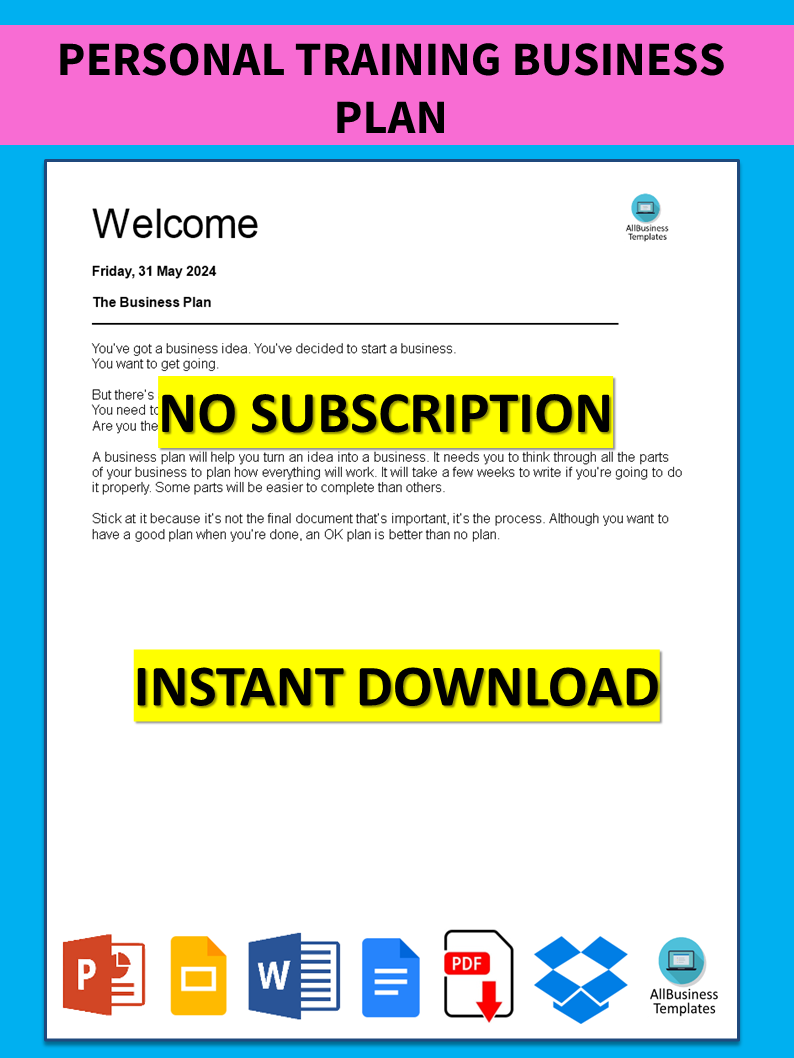Personal Training Business Plan

Enregistrer, Remplir les champs vides, Imprimer, Terminer!
Looking for a template to help you craft a successful business plan for your personal training venture? Then our personal training business plan template is what you need.
Formats de fichiers gratuits disponibles:
.docx- Ce document a été certifié par un professionnel
- 100% personnalisable
Business Entreprise business plan plan d'affaires service un service product produit plan le plan From De Personal Training Business Plan Plan de formation personnel Personal Training Business Plan Example Exemple de plan de formation personnel Personal Training Business Plan Sample Exemple de plan d'entreprise pour l'entraînement personnel Printable Business Plan Plan d'affaires imprimable
A personal training business plan can assist you in managing your organization. Is it necessary for personal training companies to have a business plan template? The structure of this personal training business plan template comprises everything essential to developing a successful business plan. Download this sample business plan template now, and use it as a guide to create your detailed plan.
Personal Training Business Plan is a comprehensive paper that contains in detail all the goals, strategies, and operational information essential to set up and run a personal training business. It serves as a roadmap that guides the business from its inception through growth stages in addition it is vital for funds, customer attraction, and future success.
Here are the key components of a personal training business plan:
Essential elements for a personal trainer's Start-up In their business plan.
Concisely explain briefly what you want to do in the future with this business plan and how your short-term goals can be achieved.
- Executive Summary
- What is the name of your personal training company?
- Where will you run it? (At a physical address, on the internet, or both)
- What are the main points of the company's mission?
- Your objectives (short-term and long-term)
- Summary of all services provided by personal trainers.
- Business Description
- Industry Overview - Gives deeper insights into the health and fitness industry and its movements as well as customer preferences.
- Business Structure - This defines the legal status of your business; whether it is an individual, partnership, or corporate entity.
- Unique Selling Idea/ Proposition (USP)- Factors that differentiate it from other companies’ offerings.
- Market Analysis
- Target market description of those who match up with what you offer (demographic and psychographic characteristics).
- Market Need – Determining if there’s any need for health services in society today.
- Competitor Analysis – An overview of both direct competitors and also indirect rivals highlighting their strong sides as well as weaknesses.
- Services offered encompass:
- Types of Training: One-on-one personal training, group classes, internet coaching, and specialized programs (for instance bodybuilding or fat reduction).
- Price Setting: Pricing models including hourly rates, package deals, and memberships plus the reasoning behind them.
- Extra Services Provided: Such as nutrition assessment, fitness tests, and so on
- Strategies for Marketing and Selling include:
- A Marketing Plan: Approaches used in luring and keeping customers in (such as social media, websites, or even local advertisements) among others
- Sales plan: Techniques for drawing leads into paying customers.
- Client Retention Plan: Ways to sustain long-lasting relationships with clients (loyalty programs and regular follow-ups).
- Operational Plan:
- Business Location: A description of your training center or how you will offer your courses online
- Daily Operations: The management of activities daily or the mundane running of a business
- Equipment and Supplies: The essential instruments and their charges
- Staffing Plan: If possible, kindly you may reach out to other additional trainers or office staff
- Financial Plan:
- Startup Costs: The first outflow of cash for establishing the enterprise (equipment, advertising, permissions, and such).
- Revenue Projections: It is the anticipated money from the services offered.
- Expense Projections: The expenses that the business will incur on rent among other things such as salaries and power bills.
- Break-even Analysis: That point at which it generates income to meet its expenditure costs.
- Funding requirements: In case of seeking external financing criteria should be given mentioning how much is needed and for what purpose it would be used.
- Appendices:
- Supporting Documents: Any other documentation that backs up your company strategy (CVs, accreditations, information on market analysis, etc).
We advise you to make use of the ‘Open with Google Docs’ button. But if it is your choice, you can download an example of personal training business plan template right away in Word to assist you improve on your efficiency. Thus you will be able to deliver well-structured and suitable business plans to clients.
AVERTISSEMENT
Rien sur ce site ne doit être considéré comme un avis juridique et aucune relation avocat-client n'est établie.
Si vous avez des questions ou des commentaires, n'hésitez pas à les poster ci-dessous.
